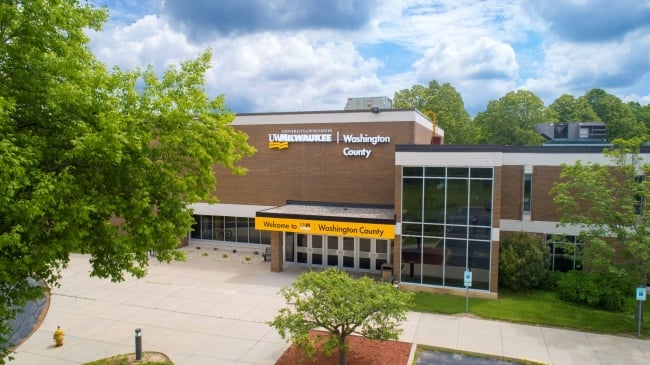You have /5 articles left.
Sign up for a free account or log in.

UW Milwaukee at Washington County is one of three branch campuses that will face full or partial closure following Tuesday’s announcement.
UW Milwaukee
The Universities of Wisconsin system plans to close a two-year branch campus and end in-person classes at two others, UW Milwaukee at Washington County and UW Oshkosh, Fond du Lac.
The decision was announced by system president Jay Rothman Tuesday. Rothman said in a press release that the decision to close UW Platteville Richland and to make UW Milwaukee at Washington County and UW Oshkosh, Fond du Lac, online only was based on enrollment shifts among traditional and nontraditional students, not cost savings.
“We are seeing freshman enrollment rising at most of our four-year campuses while enrollment at the two-year campuses has been falling at a rapid rate for years,” he said. “Moreover, online enrollment has been trending up as well. The market is telling us that increasingly students are pursuing a degree at our four-year campuses or online.”
He added that the university system should prepare for the future by aligning the branch campus with current market realities.
“The status quo is not sustainable,” he said.
The closure announcement comes at a time when local government leaders and state system administrators have been debating how best to respond to steep enrollment declines at branch campuses across the state and reduced state funding for higher ed.
Latest in Series of Changes
The branch campuses, which formerly functioned as 13 independent community colleges, have undergone significant structural change in the last six years.
UW Platteville Richland, the campus slated to close, already ended in-person classes in July, following enrollment of just 60 students in fall 2022. At its peak in 2014, the campus had a head count of 567 students, according to system data. Classes at UW Milwaukee at Washington County and UW Oshkosh, Fond du Lac, will end in June. Both campuses also experienced enrollment losses and will no longer offer in-person classes, instead becoming fully online.
The number of students enrolled at UW Milwaukee at Washington County fell from 998 in fall 2012 to 332 in fall 2022. Enrollment at UW Oshkosh, Fond du Lac, went from 692 to 258 during the same time period.
Unlike the university system over all, which saw an enrollment increase of about 540 students this fall for the first time since 2014, enrollment at most branch campuses continued to decline, with exceptions being UW Green Bay Manitowoc, UW Platteville Baraboo Sauk County, and UW Whitewater Rock County. The branch campuses started losing enrollment collectively in 2010, dropping from 13,095 students across the 13 campuses that year to 5,075 in fall 2022.
Other states have had to make similar tough decisions due to enrollment declines.
The Vermont State University System announced in August 2022 it would consolidate three institutions into one to try and keep the institutions afloat. The change went into effect this fall. But even after merging the campuses—Castleton University, Northern Vermont University and Vermont Technical College—VTSU is planning to cut 10 academic programs and up to 33 faculty positions. Administrators have also proposed consolidating 13 degree programs and reconfiguring 11 more across the system’s three campuses.
The most apt comparison to VTSU is the Pennsylvania State System of Higher Education, which merged six campuses into two new institutions last summer after years of double-digit enrollment declines and financial problems. Though Pennsylvania’s population is much larger than Vermont’s, the Keystone State has a similar demographic problem, suffering from a significant outmigration of students and falling birth rates.
County Officials Caught by Surprise
Richland County board chair Marty Brewer said he was not informed by system officials about the plan to close the campus and only learned about it on Tuesday when the news became public.
“We were surprised,” he said. “There are ways this could have been handled more diplomatically,” he added. “I still believe ongoing discussion is necessary.”
An immediate impact for the county will be the system no longer paying for utilities for the buildings, which are owned by the county. Brewer estimated the cost at around $100,000 per year. Some county board members have argued that the system should reimburse the county for maintenance costs and economic activity that will be lost with the closing, which they estimated at between $6 million and $54 million.
Charles Cornett, the Faculty Senate chair at UW Platteville, said it is “unfortunate to see the decline” in enrollment but also acknowledged, “We have to look at our limited resources.”
“We may look at it just through the lens of what is the mission of our two-year UW schools and the impact and dynamics of students seeking those opportunities,” he said. “But I think that we need to also look at the other story where we have four-year campuses that are also dealing with issues related to funding and structural deficit.”
The announcement about the ending of classes at UW Oshkosh’s Fond du Lac branch follows a tough day for faculty and staff, who learned Monday that the institution would be eliminating 250 positions through layoffs, retirements and vacancies to offset an $18 million budget shortfall, according to The Wisconsin State Journal. The actual number of cuts is even larger, because contracted instructional staff will not be rehired for the spring semester.
“Yesterday was a historically hard day at UWO. Today, it is my duty to report more change ahead,” UW Oshkosh chancellor Andy Leavitt wrote in an email to the university’s faculty, staff and students.
“I realize that these developments raise immediate questions for students and faculty and staff at each location,” Leavitt added. “Having just received President Rothman’s directive, we need time to consult with our many stakeholders, including shared governance leaders.”
David Siemers, a political science professor at UW Oshkosh and president of United Faculty and Staff Oshkosh, told the Journal he anticipates many nonfaculty employees at Fond du Lac may lose their jobs.
“This kind of surprised us all; we didn’t know this was coming. And it’s another body blow,” Siemers said. “There are people who have taught at Fond du Lac for many years, and I guess if they are faculty, they’re going to be welcome to teach up here or [at Fox Cities], but also we have to worry about our students. It’s not necessarily the case that UW Oshkosh does exactly the same thing as Fond du Lac, as much as we’d like to think of it as one university in three locations.”
‘Tough Decisions’
Josh Schoemann, the county executive in Washington County, had noticed declining enrollment at the local branch campus and even created a task force, which proposed a plan for the campus. But that plan was met with opposition. He said over the summer that he was “deeply disappointed” that local efforts to keep the campus an in-person institution failed but said Tuesday that he understands “the difficulties of making tough decisions.”
“I remain wholly committed to keeping students first as we work through this transition, fighting to keep higher education opportunities in our community for the students of today and the future,” Schoemann said in an emailed statement.
State Senator Duey Stroebel, the legislator who represents portions of Washington and Fond du Lac Counties, said, “It’s not surprising that UW Milwaukee at Washington County will be closing its doors.”
“I support any compromise amongst stakeholders (including the physical closing of UWM-WC) that would be beneficial to all parties involved in the consolidation efforts,” Stroebel said. “Moving forward, I would encourage local officials to work with all parties involved in the transition to a more sustainable model.”
Washington County will no longer be accepting new student applications. Students can apply to UW Milwaukee’s main campus, its online programs or to the nearest remaining branch campus, UW Milwaukee at Waukesha, which is about 45 minutes away.
“As we build new pathways for students, we must let go of others that are no longer sustainable,” UW Milwaukee chancellor Mark Mone said in a press release.
The planned closures will leave 10 remaining branch campuses spread throughout the state, all of them two-year liberal arts campuses operating under one of the state’s 13 four-year institutions. System president Rothman directed chancellors at the remaining campuses to discuss with local county governments future uses for the buildings that will no longer be used by the system.
Potential options could include using the buildings to offer four-year and graduate degree options, “upskilling and reskilling opportunities” for local workers, expanding dual enrollment, or opening “navigation centers” for college advising.
“Retaining the remaining branch campuses is an option that will be determined by community needs and the ability of the Universities of Wisconsin to meet those needs,” he said.








